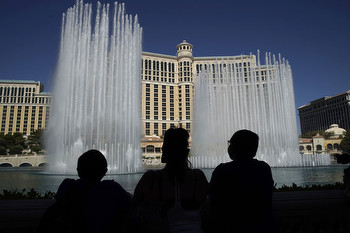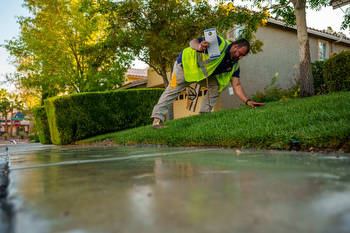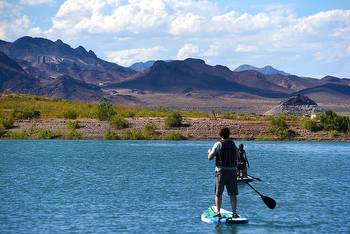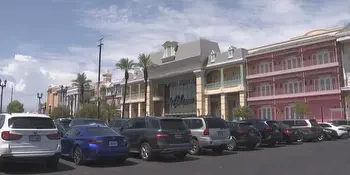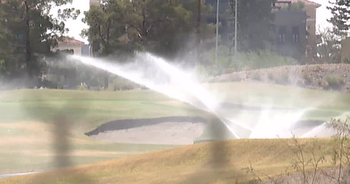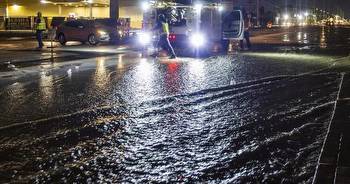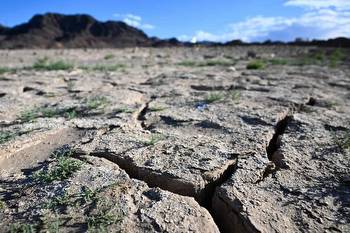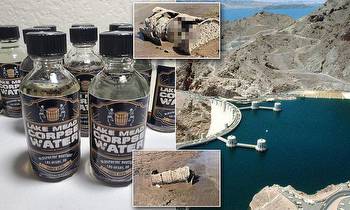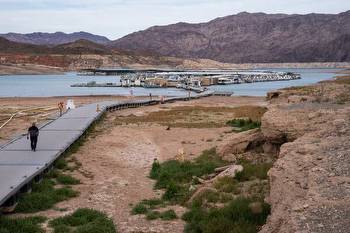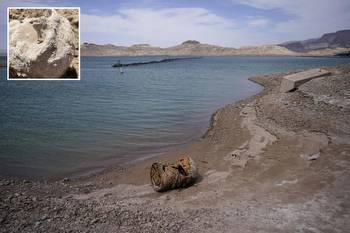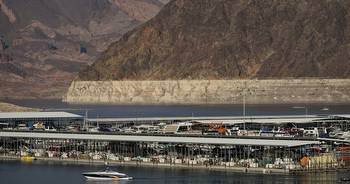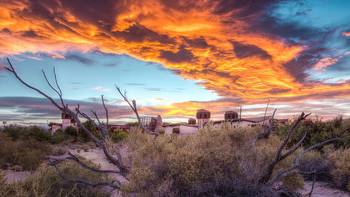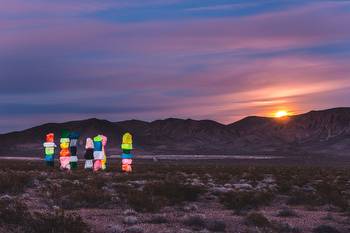Between a Desert and a Dry Place: Las Vegas and Its Water Conundrum

By Nick Erickson, Vice President, Portfolio Management
“Water, Mr. Rango, water. Without it, there’s nothing but dust and decay. But with water, there’s life. Look at them. So desperate to live, they’ll follow it anywhere. That’s the immutable law of the desert. You control the water, and you control everything.”
— Mayor Tortoise John, Rango, 2011
Key Takeaways
- The water level in Lake Mead, which supplies water to the city of Las Vegas and surrounding populations, has fallen due to a combination of decreased snowpack upstream, which is caused by a long-term drought, and a growing population and economy that likely uses more water than what is sustainable.
- If Las Vegas doesn’t address its water issue, the city’s economy will suffer. Residents will migrate to areas with adequate water supply, tourism will wane, and businesses will leave. General obligation Las Vegas debt could be rendered worthless as the bonds are backed by property tax revenues.
- It appears that neither the underlying credit rating nor the current market yield reflects the risks faced by Las Vegas.
It’s not often that an animated children’s film can provide startlingly relevant quotes and accurate context to real-world situations, but Rango does exactly that. It appears the 2011 movie was tailormade to help portray the real-life environmental situation facing the municipality of Las Vegas. A city of glitz, glamour, and gambling, Las Vegas is also a city built in a desert, and its main source of water is becoming increasingly less dependable. To understand the challenges facing Las Vegas, it helps to know where its water comes from, how it is stored, and who the users are before diving into water use policies, which ultimately may be what exposes the economy of Las Vegas as a mirage in the desert.
The Lifeblood of Las Vegas
Any talk about the water supply in the Southwest U.S. – be it Southern Nevada, Northwest Arizona, or Southern California – begins with the winter snowpack of the Western Rockies in Colorado and ends with the water levels of the upper and lower Colorado River Basins. Snow deposited by winter storms builds up in the Western Rockies during the winter. When spring arrives, this snowpack begins to melt and feed the various streams and rivers that make up the beginning of the Colorado River and the Colorado River Basin. This snowpack continues to melt throughout the summer, supplying the rivers and consumers downriver with much-needed freshwater throughout the year before the cycle begins again with the next round of snowstorms in the fall and winter.
The importance of this winter snowpack cannot be overstated. As it melts in the spring, it saturates downstream soils and fills reservoirs with the water they need to sustain these downstream populations. But climate change, in the form of reduced snowfall year over year, is causing a slow and steady depletion of the downstream water reserves. Combine this with a growing residential and commercial population demanding more water, and we have a water scarcity issue that can greatly impact the social and economic foundations that these downstream municipalities are built upon. Being cognizant of how impactful access to water can be for a municipality, and therefore that municipality’s debt, should be a credit consideration for any national municipal investor.
Going Down? Snow Packs, Lake Levels, and Pump Station Depths
The Colorado River Basin is generally composed of two parts, the Upper Basin and the Lower Basin. The Upper Basin contains Lake Powell, an artificial reservoir of the Colorado River that spans Southern Utah and Northern Arizona. The Lower Basin contains Lake Mead, an artificial reservoir in the Colorado River that spans Western Arizona and Southern Nevada. After Lake Mead, the Colorado River is allowed to run its course as it feeds canals stretching across Southern California and Western Arizona, supplying water to large farming operations. Eventually the river empties into the Gulf of California.
Both Lake Powell and Lake Mead act as reservoirs to trap and store excess water that is to be consumed at a later time within the region. Lake Powell acts as an initial storage basin for water that will eventually be used by residents and businesses that are tapped into Lake Mead. Lake Mead supplies water to approximately 25 million people in Nevada, Arizona, and California. Therefore, its continued sustenance is extremely vital to the health and wellbeing of the region’s ecology and economy. Since its inception in 1933, Lake Mead had averaged 1,173 feet of water, with a full pool being just shy of 1,225 feet. Since about 2000, the lake elevation has been trending down to its current average of 1,064 feet.
Under most scenarios, Lake Mead is forecast to continue its slow and steady decline in pool elevation over the next five years.
Lake Mead End-of-Month ElevationsBureau of Reclamation
This continued downward trend will continue to put a strain on electricity generators and, more importantly, the water providers that depend on the lake. Southern Nevada Water Authority (SNWA) provides wholesale water treatment and delivery for the greater Las Vegas Valley and is responsible for acquiring and managing long-term water resources for Southern Nevada. Such providers are having to proactively construct additional pumping stations that allow them to access Lake Mead at lower lake levels, with their initial Pumping Station 1 being just above the current water level. In addition, they have activated the Low Level Pumping Station, which, as the deepest drilled station, is the last resort scenario for Las Vegas to avoid a “Day Zero” which would be the cessation of access to fresh water. Considering the area obtains approximately 90% of its drinking water from the Colorado River, this type of event would have a catastrophic effect on the local population and subsequently the economy.
The last things to consider when it comes to the Colorado River Basin are the legally binding water agreements among the seven Colorado River basin states, the federal government, and Mexico. The agreements determine how much water each gets, when cuts are triggered, and the order in which the parties must sacrifice some of their supply. Under a 2019 drought contingency plan, Arizona, Nevada, California, and Mexico agreed to give up shares of their water to maintain water levels at Lake Mead, but it hasn’t been enough to stop the steady decline in water levels. So, if water levels in Lake Mead are continuing to drop, even after the agreed-upon cuts, which municipality is at the largest risk of the environmental, social, and economic impacts from this water shortage? The answer is Las Vegas.
Viva Las Aqua
Las Vegas is in Clark County in southern Nevada. Geographically, it sits in a basin within the Mojave Desert and is surrounded by desert vegetation and dry mountain ranges. The peaks in these mountain ranges reach elevations of over 10,000 feet and act as barriers to the strong flow of moisture from the surrounding area.
In the Las Vegas metropolitan area, there are three main groups of water users: public amenities, commercial users, and residential users.
- Public amenities: Public amenities are government-developed public spaces such as parks, green spaces, medians, and bodies of water. The number of public amenities that utilize water resources are relatively small when compared to commercial or residential. The problem lies in the sheer quantity of water resources utilized by a single entity. Lake Las Vegas is an artificial reservoir created by property developers to create a resort-like community. Lake Las Vegas pulls its water from Lake Mead and is currently the single-largest consumer of water within the water district, using 1.2 billion gallons of water in 2020.
- Commercial users: The largest industries in Las Vegas are tourism, gaming, and conventions. Within the context of these industries reside subcategories that feed into these industries, namely casino hotels and golf courses, and these subindustries use a lot of water. Golf courses make up four of the top ten commercial water users in the area, averaging approximately 420 million gallons of water per year. Next on the list are the casino hotels, comprising five of the top ten commercial water users, averaging approximately 370 million gallons of water per year.
- Residential users: Las Vegas’s population currently sits at approximately 2.8 million full-time residents and is expected to grow to an estimated 3.3 million over the next fifteen years. This residential population uses an estimated 222 gallons of water per day per household. This equates to approximately 488 million gallons of water per day in total. Over the course of a year, this is approximately 178 billion gallons of water used by the residential population, which is by far the largest user base.
When it comes to water conservation resources, the residential user base would be the most impactful place to start. Facing a long-term drought, a forecasted population, and with a history of water use to maintain water-intensive programs (i.e., golf, lawns, lakes), the Southern Nevada Water Association (SNWA) has started to introduce programs and initiatives to conserve water within their residential user base. But are they doing enough, especially when compared to other water authorities that have faced droughts and have a relatively similar water resource profile?
In the table below, we compare Las Vegas to Austin, Texas, in terms of their city general obligation debt rating, their Climate Risk and Readiness category, and their residential water use policies and initiatives.
Las Vegas vs. AustinND-Gain, SNWA
Municipal investors should have an eye toward climate-related stresses, and several things are worth highlighting in this comparison. The first, and most obvious, is the perceived drought risk levels being faced by these municipalities. The ND-GAIN Urban Adaptation Assessment is an interactive database with more than 270 U.S. municipalities that explores the connection between vulnerabilities to climate disasters, adaptive capacities, and how these are distributed within a city. From an economic standpoint, Las Vegas is considered to be at high risk of exposure to a drought because it lacks the adaptive capacity, in the form of a drought or water management plan and has a relatively high population density when compared to Austin.
Climate Risk: Las Vegas vs. AustinND-GAIN
The second factor that creates concern is residential water use policies. Las Vegas has a much more accommodative residential water use policy geared toward their largest water user base. While this policy in baseline climate times may be adequate, in times of climate stress or drought, of which Las Vegas is currently in, this water use policy seems excessive and puts the municipality and the sustainability of its economies at risk, especially when comparing it to Austin, Texas’s water use policy and its perceived lower drought risk.
Faced with an uncertain climate and declining water supplies caused by insufficient snowpack, increased demand due to population growth, and industries that are water intensive, the Las Vegas metropolitan area faces a daunting task of pinpointing exactly how much water they can use while maintaining the character of the population and industries that were built upon it. For municipal investors, it is important to make sure they are being adequately compensated for this forward-looking, long-term climate risk that Las Vegas is facing. As it stands now, it appears that neither the underlying credit rating, nor the current market yield reflect this risk when compared to Austin. Granted a ten-year time frame may not have a material impact on the economic outlook of either municipality, but it helps highlight some additional factors to be considered when investing in long-term debt. Only time will tell if Mother Nature grants Las Vegas a reprieve through increased snowfall, if conservation efforts pay off with a long-term sustainable water plan, or if the desert will eventually reclaim the area as the population moves to a more hospitable location.
- Bloomberg, Bloomberg.
- Bureau of Reclamation, 5-Year Probabilistic Projections, February 25, 2022.
- Moody’s ESG Solutions, Comprehensive ESG Coverage, September 18, 2020.
- Notre Dame Global Adaptation Initiative, Urban Adaptation Assessment, March 4, 2019.
- Southern Nevada Water Authority, Low Lake Level Pumping Station.
For more news, information, and strategy, visit the ETF Strategist Channel.
Disclosures: This is for informational purposes only and is not intended as investment advice or an offer or solicitation with respect to the purchase or sale of any security, strategy or investment product. Although the statements of fact, information, charts, analysis and data in this report have been obtained from, and are based upon, sources Sage believes to be reliable, we do not guarantee their accuracy, and the underlying information, data, figures and publicly available information has not been verified or audited for accuracy or completeness by Sage. Additionally, we do not represent that the information, data, analysis and charts are accurate or complete, and as such should not be relied upon as such. All results included in this report constitute Sage’s opinions as of the date of this report and are subject to change without notice due to various factors, such as market conditions. Investors should make their own decisions on investment strategies based on their specific investment objectives and financial circumstances. All investments contain risk and may lose value. Past performance is not a guarantee of future results.
Sage Advisory Services, Ltd. Co. is a registered investment adviser that provides investment management services for a variety of institutions and high net worth individuals. For additional information on Sage and its investment management services, please view our web site at www.sageadvisory.com, or refer to our Form ADV, which is available upon request by calling 512.327.5530.








